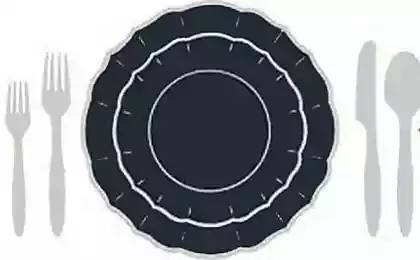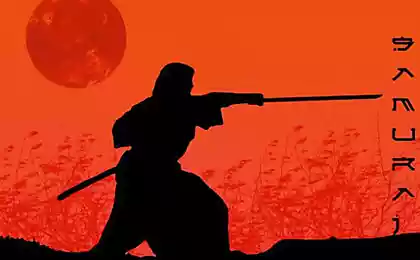1129
The subtleties of Japanese etiquette
Japan - a country of high technology, sushi, cherry and Mount Fuji. Its culture - is complex and mysterious. Foreigners do not understand why Japanese people allow themselves to loud smack one's lips at the table, do not open the door to women and do not pass them forward.
In this article you will learn a lot about Japanese etiquette: how to welcome companion how to handle chopsticks, how to behave in public transport and so on. N.
via lifehacker.ru
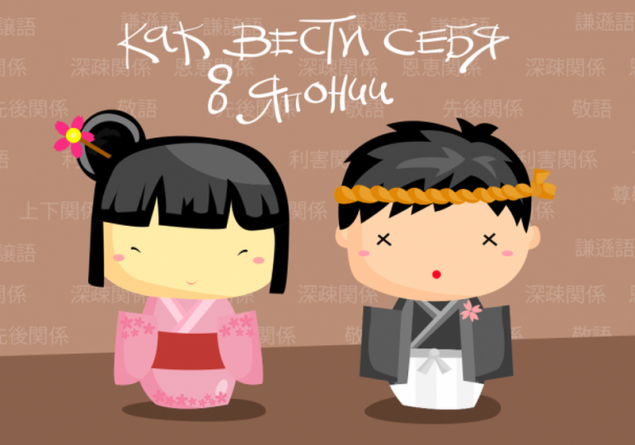
Japanese etiquette - a complex "science».
Its origins lie in Confucianism, Shintoism, as well as a strict hierarchical system of Japanese society.
The Japanese almost always polite and calm. They understand that the Europeans is difficult to adapt to their culture and relate to errors in the behavior of the tourists with good irony. That is why knowledge of a foreigner of Japanese tradition makes them genuine respect.
Magic words
Appeal to the other party
Nihongo but keysё - this is the suffix used in communication, and added to the name, surname or profession man. They point to the closeness of the interlocutors and social ties between them. Handling without suffix - rudeness. It is allowed only in communication between pupils, students and close friends, as well as the handling of the adult to the child.
Basic Nihongo but keysё:
•
san - is used in communication between people of equal social status, younger to older, as well as unfamiliar people to show grudging respect (something like our "You»);
•
kun - used in informal communication between colleagues, friends, and also for treatment of big-endian (subordinate to the Head);
•
-chan - used in close communion between people of equal social status and age, as well as appealing to children (something like a diminutive form of the Russian language);
•
-The most - used to express an extreme degree of respect, usually in the official letters (something like "lord»);
•
-sempay - used when handling youngest to the oldest (teacher - student, less experienced employees - more experienced);
•
-kohay - reverse "-sempay»;
•
-sensey - used when referring to the scientists, doctors, writers, politicians and other distinguished personalities in the society.
Welcome!
Greeting - an important part of Japanese culture. Most often it is expressed in a bow (more on that later), but used the words:
•
Ohaё godzaymasu - good morning.
•
Konnitiva - Good afternoon.
•
Konbanwa - Good evening.
•
Hisasiburi desu - long time no see.
It is also used, and these informal options like "Ossa", "Yahho", "Ooi!" (In male company).
Goodbye!
To say goodbye, say in Japan:
•
Sayonara - bye.
•
Matane - while, I'll see you.
•
Oyasumi NASA or just oyasumi - goodnight.
Thank
Thanks in Japan so:
•
Domo - thanks.
•
Domo arigato - thank you very much.
•
Domo arigato godzaimas - much more thanks.
Please
And the answer so courtesy:
•
Doitasimasite - no thanks.
•
Kotirakoso - thank you.
•
Otsukare itself - a great job.
Requests
To ask for help, you need to say "onegai" or "kudasai." But in Japan, it is not accepted to request (only in the most extreme cases). Therefore, the rejection of aid - is not rudeness, but rather an expression of respect. Take someone's support is only when a person is willing to help a few times in a row.
Apologies
Conventional apology - "Gomen NASA" and "Sumimasen." Last translates literally as "I have no forgiveness" and used very often. So the Japanese show as much respect for the interlocutor who brought any inconvenience.
Body language
The words are secondary to the Japanese. Much (if not all) they express in sign language.
The main rule in dealing with the Japanese - do not violate personal space.
Talking to the unfamiliar person, keep your distance. No familiarly pat on the back and hugs, no invasion of personal comfort zone.
Looking
"Eyes - mirror of the soul" - we considered. The Japanese are not used to flaunt his soul, they almost never look into the eyes of the interlocutor.
So it was led from the ancient times: it was impossible to look into the eyes of people standing above you on the social ladder. This was considered unheard of rudeness.
Today, open look straight in Japan - a sign of aggression, a challenge. For example, when parents abuse their teenage children, they do not perechat them and just blatantly look at the eyes.
If the Japanese in conversation constantly look away, do not think that he is cunning, or hiding something. This is normal. To this we must get used to.
Bow
Hello, thanks, apology, respect - all expressed through the Japanese bows. Bow (ojigi) - an integral part of Japanese culture. Some bow, even talking on the phone (on the automatic, unconscious). Correct bow - a sign of good breeding.
There are three types of bows:
•
Eshaku - short barely perceptible nod, bending back the entire 15º. Widely used in daily life, to welcome friends and unfamiliar people higher status, or as a "thank you».
•
Keirei - deeper (30º) and a little more than a long bow. So welcome esteemed colleagues, business partners.
•
Sai-Keirei - the strongest (45º) and a long bow, expresses deep respect for the person, it is used to greet VIPs.
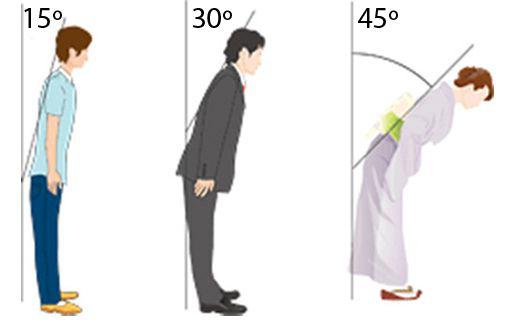
In order to properly worship the need:
1
Stop.
2
Stand in front of the interlocutor.
3
Pressed her hands to her hips and put them in front of him (gassho).
4
Take a bow.
Note that the Japanese are very progressive. In communicating with foreigners, they are increasingly using the customary handshake for the Europeans (especially in business).
Visiting
The Japanese rarely invited guests to the house (especially foreigners). And it's not starkness. Just his own, and not removable, the house - it is a rarity, and its area is poor.
If you received an invitation to come for a visit - you great honor. Refusing extremely rude.
Gifts
Going to visit with empty hands is impossible.
Gifts - an important part of Japanese culture.
They give for the holidays, for special occasions, as a sign of respect, and so on. D.
This is very important symbolism and ceremony. There is even a special term "bunker" - the art of gift giving.
Basic rules of gift giving:
•
The gift must be packed.
•
Gift (just like any other thing, do solemnly transmitted from person to person) should transmit and receive with both hands.
•
It is impossible to unpack a gift (a sign of curiosity and greed).
•
The gift should be practical and correspond to the case (often donated money).
•
The gifts do not have to figure number 4 (a homophone of the character's death).
•
For a gift (even if it is very expensive) should "apologize" (your humble gift still can not express the respect that you have for bestow).
•
In response to the gift received in the mail, I decided to write thank-you letters.

So, according to the rules of etiquette Japanese guest, entering the house, the guest must stay in the lobby ("chenkan"), where he was met by the owners. Guest must present a gift to the hostess and apologize to bother them with a visit. The owners, in turn, apologize for having taken such a modest guest.
After this exchange of courtesies, you can enter the house.
Shoes
There foreigner waiting for a catch. In America and Europe take off one's shoes is not accepted, entering the premises. In Japan, it is obligatory.
Sign shod in the house - a gross violation of Japanese etiquette. Japanese forgive inexperienced foreigners, many mistakes, but not this one. In Japan, some provincial towns, shoes removed, even coming to work.
So, before you cross the threshold of the Japanese house, you need to take off our shoes.
Sometimes you will be offered slippers, sometimes not. It offers a second catch - always ensure the purity and integrity of his socks.
The third trick lurking near the restroom. Near the entrance to the bathroom or toilet in the Japanese house are still some special slippers (rather shale, with special inscriptions). "And let him stand" - think a foreigner and step over the threshold into the house slippers or barefoot, risking thus expose themselves to ridicule. To visit the restroom it is necessary to change the shoes.
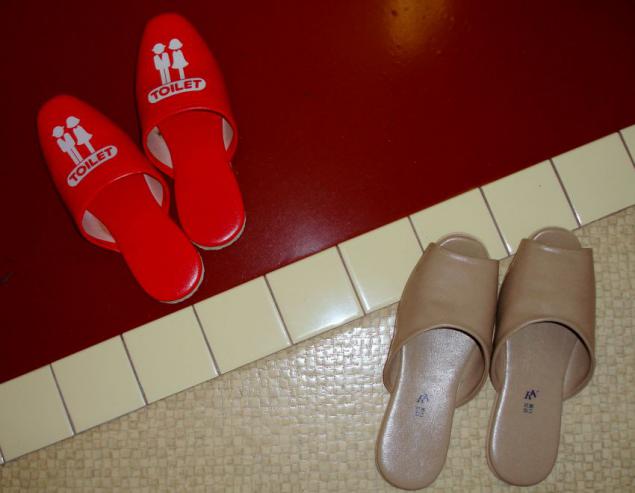
In transport
In Japan, there are several important rules of conduct in public places, including transportation:
•
You can not scream (do not holler loud person in the crowd, even if it is your friend).
•
You can not be rude and respond to shocks (pushed and stepped on transportation often (imagine the Tokyo subway passenger traffic), but no breaks and no scandals, all suffer).
•
You can not talk on a cell phone at the station, bus stop and all the more in a train - it disturbs the other passengers and is considered a top uncultured (all write SMSki).
•
You can not sit in the car for women, if you are a man (in the evening on some branches of shuttle trains with cars designed only for passengers, in order to protect them from harassment during the stampede).
•
You can not blow your nose in public.
•
You should not give way to the grandmother (for seniors and people with disabilities have special places illegally occupy that no one would dream of).
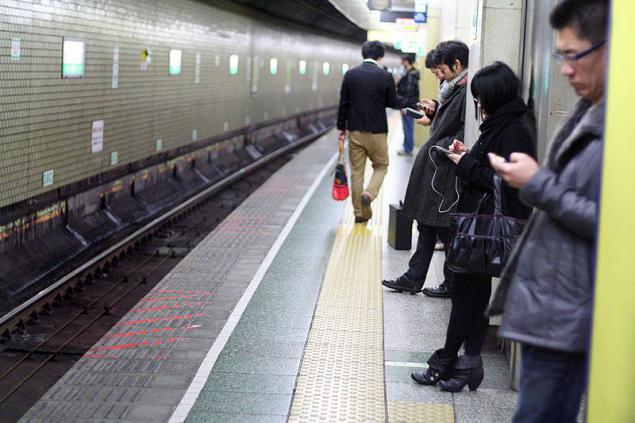
At the table
Home meal
Before the beginning of dinner (the classic canons) is applied wet hot towel to clean your hands and face - "osibori." But if you eat in a normal restaurant, osibori may not be.
But no matter where you ate before you start eating, you say "Itadakimas» (Itadakimasu - «I gratefully accept this food"). This is instead of "bon appetit».
With regard to the sequence of dishes (again, a traditional dinner), you must first taste the rice, the soup and then, and only then try any other dishes.
Sticks
Khasi - traditional chopsticks. Hasioki - stand under them. The ability to use chopsticks - an indicator of human culture.

Toasts
«Kanpai!» - As the Japanese say, raising a glass of sake (or other alcohol) and clinking glasses. Translated, it means "Bottoms up!».
But drinking is dangerous to the bottom. Once the dispensing sees the empty glass, he immediately fill it. By the way, if you drink bottled, then fill your glass should be in the least.
End the meal
Silently exit from the table - bad form. It is necessary to thank the one who fed you (owners of the house, the chef of the restaurant), even if he can not hear you. To do this, say "Gochisosama» (Gochisosama).
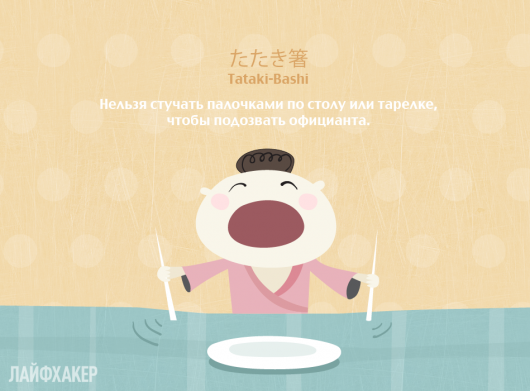
A couple more tips
1
Do not be surprised with a loud smacking the table - as the Japanese express the pleasure of eating.
2
Do not try to give a tip - it is not accepted.
Networking
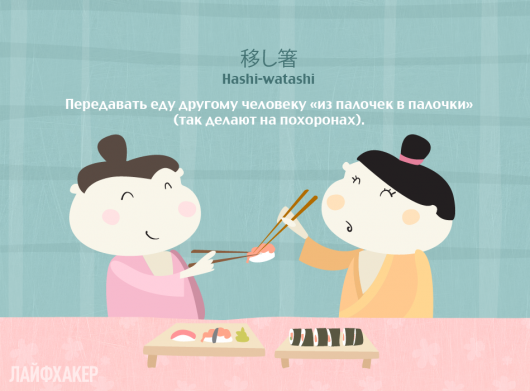
The Japanese are experts in the business. To earn the trust and respect of Japanese partners, need to know a few basic rules of national business etiquette.
Delays
The Japanese are never late. Making Japanese wait means disrespect. It is better to come to the meeting earlier than late.
No!
Hear from a Japanese businessman outright refusal - this is nonsense.
The Japanese did not say "No».
Even if the terms of the deal are not fully satisfied with them. Instead, the Japanese will nod and give evasive answers abstract ("We think," "It is difficult" and so on. D.). The origins of such behavior in the "timmoku" (the Japanese art of silence) - it is better to remain silent than to offend a person's refusal.
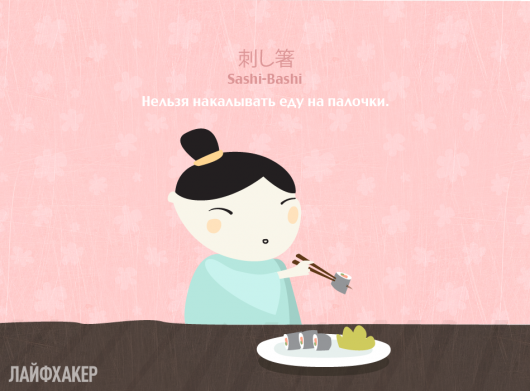
If the deal is fully satisfied with the Japanese, you will hear a clear and unambiguous "Yes».
Business cards
Exchange business cards - an important ceremony of the Japanese business communication. First, the card - a kind of cheat sheet (Japanese difficult given European names, as well as our Japanese). Secondly, on the business card contains the position that allows you to choose the right strategy. Thirdly, it is a sign of respect for the partner.
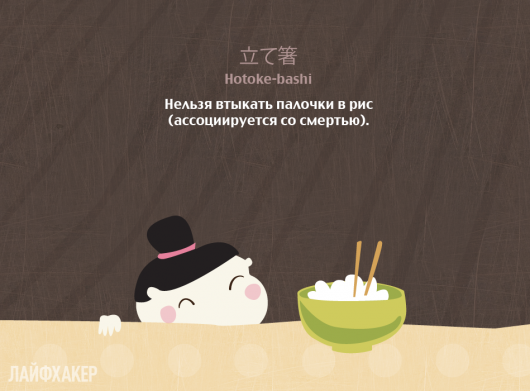
...
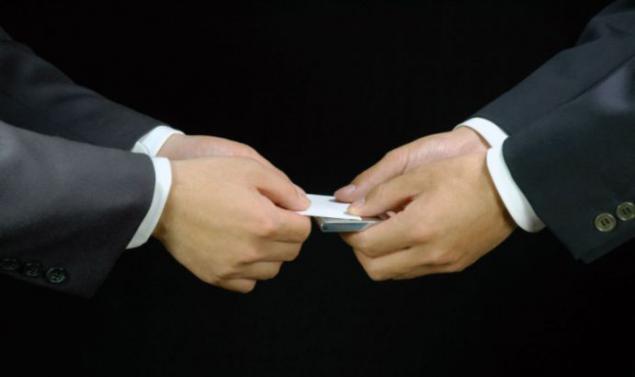
Source: http: //
In this article you will learn a lot about Japanese etiquette: how to welcome companion how to handle chopsticks, how to behave in public transport and so on. N.
via lifehacker.ru

Japanese etiquette - a complex "science».
Its origins lie in Confucianism, Shintoism, as well as a strict hierarchical system of Japanese society.
The Japanese almost always polite and calm. They understand that the Europeans is difficult to adapt to their culture and relate to errors in the behavior of the tourists with good irony. That is why knowledge of a foreigner of Japanese tradition makes them genuine respect.
Magic words
Appeal to the other party
Nihongo but keysё - this is the suffix used in communication, and added to the name, surname or profession man. They point to the closeness of the interlocutors and social ties between them. Handling without suffix - rudeness. It is allowed only in communication between pupils, students and close friends, as well as the handling of the adult to the child.
Basic Nihongo but keysё:
•
san - is used in communication between people of equal social status, younger to older, as well as unfamiliar people to show grudging respect (something like our "You»);
•
kun - used in informal communication between colleagues, friends, and also for treatment of big-endian (subordinate to the Head);
•
-chan - used in close communion between people of equal social status and age, as well as appealing to children (something like a diminutive form of the Russian language);
•
-The most - used to express an extreme degree of respect, usually in the official letters (something like "lord»);
•
-sempay - used when handling youngest to the oldest (teacher - student, less experienced employees - more experienced);
•
-kohay - reverse "-sempay»;
•
-sensey - used when referring to the scientists, doctors, writers, politicians and other distinguished personalities in the society.
Welcome!
Greeting - an important part of Japanese culture. Most often it is expressed in a bow (more on that later), but used the words:
•
Ohaё godzaymasu - good morning.
•
Konnitiva - Good afternoon.
•
Konbanwa - Good evening.
•
Hisasiburi desu - long time no see.
It is also used, and these informal options like "Ossa", "Yahho", "Ooi!" (In male company).
Goodbye!
To say goodbye, say in Japan:
•
Sayonara - bye.
•
Matane - while, I'll see you.
•
Oyasumi NASA or just oyasumi - goodnight.
Thank
Thanks in Japan so:
•
Domo - thanks.
•
Domo arigato - thank you very much.
•
Domo arigato godzaimas - much more thanks.
Please
And the answer so courtesy:
•
Doitasimasite - no thanks.
•
Kotirakoso - thank you.
•
Otsukare itself - a great job.
Requests
To ask for help, you need to say "onegai" or "kudasai." But in Japan, it is not accepted to request (only in the most extreme cases). Therefore, the rejection of aid - is not rudeness, but rather an expression of respect. Take someone's support is only when a person is willing to help a few times in a row.
Apologies
Conventional apology - "Gomen NASA" and "Sumimasen." Last translates literally as "I have no forgiveness" and used very often. So the Japanese show as much respect for the interlocutor who brought any inconvenience.
Body language
The words are secondary to the Japanese. Much (if not all) they express in sign language.
The main rule in dealing with the Japanese - do not violate personal space.
Talking to the unfamiliar person, keep your distance. No familiarly pat on the back and hugs, no invasion of personal comfort zone.
Looking
"Eyes - mirror of the soul" - we considered. The Japanese are not used to flaunt his soul, they almost never look into the eyes of the interlocutor.
So it was led from the ancient times: it was impossible to look into the eyes of people standing above you on the social ladder. This was considered unheard of rudeness.
Today, open look straight in Japan - a sign of aggression, a challenge. For example, when parents abuse their teenage children, they do not perechat them and just blatantly look at the eyes.
If the Japanese in conversation constantly look away, do not think that he is cunning, or hiding something. This is normal. To this we must get used to.
Bow
Hello, thanks, apology, respect - all expressed through the Japanese bows. Bow (ojigi) - an integral part of Japanese culture. Some bow, even talking on the phone (on the automatic, unconscious). Correct bow - a sign of good breeding.
There are three types of bows:
•
Eshaku - short barely perceptible nod, bending back the entire 15º. Widely used in daily life, to welcome friends and unfamiliar people higher status, or as a "thank you».
•
Keirei - deeper (30º) and a little more than a long bow. So welcome esteemed colleagues, business partners.
•
Sai-Keirei - the strongest (45º) and a long bow, expresses deep respect for the person, it is used to greet VIPs.

In order to properly worship the need:
1
Stop.
2
Stand in front of the interlocutor.
3
Pressed her hands to her hips and put them in front of him (gassho).
4
Take a bow.
Note that the Japanese are very progressive. In communicating with foreigners, they are increasingly using the customary handshake for the Europeans (especially in business).
Visiting
The Japanese rarely invited guests to the house (especially foreigners). And it's not starkness. Just his own, and not removable, the house - it is a rarity, and its area is poor.
If you received an invitation to come for a visit - you great honor. Refusing extremely rude.
Gifts
Going to visit with empty hands is impossible.
Gifts - an important part of Japanese culture.
They give for the holidays, for special occasions, as a sign of respect, and so on. D.
This is very important symbolism and ceremony. There is even a special term "bunker" - the art of gift giving.
Basic rules of gift giving:
•
The gift must be packed.
•
Gift (just like any other thing, do solemnly transmitted from person to person) should transmit and receive with both hands.
•
It is impossible to unpack a gift (a sign of curiosity and greed).
•
The gift should be practical and correspond to the case (often donated money).
•
The gifts do not have to figure number 4 (a homophone of the character's death).
•
For a gift (even if it is very expensive) should "apologize" (your humble gift still can not express the respect that you have for bestow).
•
In response to the gift received in the mail, I decided to write thank-you letters.

So, according to the rules of etiquette Japanese guest, entering the house, the guest must stay in the lobby ("chenkan"), where he was met by the owners. Guest must present a gift to the hostess and apologize to bother them with a visit. The owners, in turn, apologize for having taken such a modest guest.
After this exchange of courtesies, you can enter the house.
Shoes
There foreigner waiting for a catch. In America and Europe take off one's shoes is not accepted, entering the premises. In Japan, it is obligatory.
Sign shod in the house - a gross violation of Japanese etiquette. Japanese forgive inexperienced foreigners, many mistakes, but not this one. In Japan, some provincial towns, shoes removed, even coming to work.
So, before you cross the threshold of the Japanese house, you need to take off our shoes.
Sometimes you will be offered slippers, sometimes not. It offers a second catch - always ensure the purity and integrity of his socks.
The third trick lurking near the restroom. Near the entrance to the bathroom or toilet in the Japanese house are still some special slippers (rather shale, with special inscriptions). "And let him stand" - think a foreigner and step over the threshold into the house slippers or barefoot, risking thus expose themselves to ridicule. To visit the restroom it is necessary to change the shoes.

In transport
In Japan, there are several important rules of conduct in public places, including transportation:
•
You can not scream (do not holler loud person in the crowd, even if it is your friend).
•
You can not be rude and respond to shocks (pushed and stepped on transportation often (imagine the Tokyo subway passenger traffic), but no breaks and no scandals, all suffer).
•
You can not talk on a cell phone at the station, bus stop and all the more in a train - it disturbs the other passengers and is considered a top uncultured (all write SMSki).
•
You can not sit in the car for women, if you are a man (in the evening on some branches of shuttle trains with cars designed only for passengers, in order to protect them from harassment during the stampede).
•
You can not blow your nose in public.
•
You should not give way to the grandmother (for seniors and people with disabilities have special places illegally occupy that no one would dream of).

At the table
Home meal
Before the beginning of dinner (the classic canons) is applied wet hot towel to clean your hands and face - "osibori." But if you eat in a normal restaurant, osibori may not be.
But no matter where you ate before you start eating, you say "Itadakimas» (Itadakimasu - «I gratefully accept this food"). This is instead of "bon appetit».
With regard to the sequence of dishes (again, a traditional dinner), you must first taste the rice, the soup and then, and only then try any other dishes.
Sticks
Khasi - traditional chopsticks. Hasioki - stand under them. The ability to use chopsticks - an indicator of human culture.

Toasts
«Kanpai!» - As the Japanese say, raising a glass of sake (or other alcohol) and clinking glasses. Translated, it means "Bottoms up!».
But drinking is dangerous to the bottom. Once the dispensing sees the empty glass, he immediately fill it. By the way, if you drink bottled, then fill your glass should be in the least.
End the meal
Silently exit from the table - bad form. It is necessary to thank the one who fed you (owners of the house, the chef of the restaurant), even if he can not hear you. To do this, say "Gochisosama» (Gochisosama).

A couple more tips
1
Do not be surprised with a loud smacking the table - as the Japanese express the pleasure of eating.
2
Do not try to give a tip - it is not accepted.
Networking

The Japanese are experts in the business. To earn the trust and respect of Japanese partners, need to know a few basic rules of national business etiquette.
Delays
The Japanese are never late. Making Japanese wait means disrespect. It is better to come to the meeting earlier than late.
No!
Hear from a Japanese businessman outright refusal - this is nonsense.
The Japanese did not say "No».
Even if the terms of the deal are not fully satisfied with them. Instead, the Japanese will nod and give evasive answers abstract ("We think," "It is difficult" and so on. D.). The origins of such behavior in the "timmoku" (the Japanese art of silence) - it is better to remain silent than to offend a person's refusal.

If the deal is fully satisfied with the Japanese, you will hear a clear and unambiguous "Yes».
Business cards
Exchange business cards - an important ceremony of the Japanese business communication. First, the card - a kind of cheat sheet (Japanese difficult given European names, as well as our Japanese). Secondly, on the business card contains the position that allows you to choose the right strategy. Thirdly, it is a sign of respect for the partner.

...

Source: http: //










